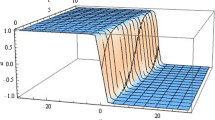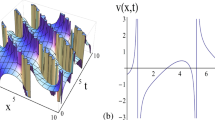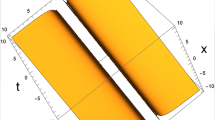Abstract
This paper obtains exact travelling wave solutions of five various forms of the generalized nonlinear Klein–Gordon equations using Jacobi elliptic functions. Topological and non-topological soliton solutions are obtained as well as Jacobi elliptic function solutions. It is acquired constraint conditions for the existence of solitons.
Similar content being viewed by others
Explore related subjects
Discover the latest articles, news and stories from top researchers in related subjects.Avoid common mistakes on your manuscript.
1 Introduction
The theory of solitons plays a vital role in various areas of Physics and Engineering. It has very wide applications in nonlinear optics, fluid dynamics, nuclear physics, biophysics, plasma physics and many more [1,2,3,4,5,6,7,8,9,10,11,12,13,14,15,16,17,18,19,20,21,22,23,24,25]. A soliton is usually associated with solution of a nonlinear evolution equation which represents a wave of permanent form. Because of that the study of nonlinear evolution equations has become a very important area in the fields of physics, mathematics and engineering. There are many newly developed techniques to carry out integration of these equations. These methods include exponential function method, G’/G method, sine-cosine method, tanh-coth method, Adomian decomposition method, Wadati trace method and many more.
The Klein–Gordon equation (KGE) is a very important equation in the study of nonlinear evolution equations which has wide applications in the field of Quantum Physics [1,2,3,4,5,6,7,8,9,10,11,12,13,14]. This paper focuses five various generalized forms of this equation. It is obtained topological and non-topological soliton solutions as well as Jacobi elliptic function solutions of the generalized KGEs in this study.
2 Governing equation
The gKGE that will be considered in this study is given by [1]
where k is a real number, m is a positive integer and \(m\ge 1.\) In the case of \(m=1,\) the gKGE reduces the regular KGE [10, 12]. In (1), q(x, t) represents the quantized field describing the particle, and F(q) is a continuous nonlinear function and it can be written as
where \(U\left( q\right) \) is a potential function. The function F(q) will be addressed as five various forms in this paper as follows:
Here, a, b and c are real-valued constants for above-mentioned five forms.
3 Form-I
In this case considering Eqs. (1) and (3), the generalized form of the quadratic nonlinear KGE is given by
We first introduce the following hypothesis
where
Here, \(\ell \) is the modulus of Jacobi elliptic function and it is defined as \(0<\ell <1\). A represents the amplitude, B represents the inverse width of the soliton, v is the soliton velocity and the unknown index p will be determined. It is obtained from the Eq. (9)
Substituting (11) and (12) into (8) yields
Now, from (13) matching the exponents \(mp+2\) and 2mp, one needs to have
which leads to
Equating coefficients of them and setting coefficients of \(sn^{mp+j}\left( \tau ,\ell \right) ,\) for \(j=-2,0\), to zero in (13), as these are linearly independent functions, yields
and
From (17), it is important to note that
and if m is even, \(ab>0\) in (16). Thus, Jacobi elliptic function solution of (8) is given by
If the modulus \(\ell \rightarrow 1\) in Eq. (18), we get following topological soliton solution
Now, to get other solutions of (8), we use the assumption as
Thus, one obtains
So, Eq. (8) reduces
Matching the exponents \(mp+2\) and 2mp gives the same value of which is in (15). Equating coefficients of them and setting coefficients of \(cn^{mp+j}\left( \tau ,\ell \right) \) to zero for \(j=-2,0\), one gets
and
It is important to note that
in (25) and also
if m is even in (24). So, another Jacobi elliptic function solution of (8) is given by
From (26), if the modulus \(\ell \rightarrow 1,\) we get following 1-soliton solution of (8).
where \(a\left( v^{2}-k^{2}\right) >0\) and if m is even \(ab>0.\)
Remark 1
4 Form-II
Taking into consideration Eqs. (1) and (4) together gives
This equation is the generalized form of the phi-four model. In order to get solutions of this equation, we use the same starting assumption as given by (9). Substituting (11) and (12) into (28) yields
For the exponent of sn in the third and last terms to match up, one needs to have
which yields
Equating coefficients of this third and last terms and setting coefficients of \(sn^{mp+j}\left( \tau ,\ell \right) \), for \(j=-2,0\), to zero in (29) yields
and
Equations (32) and (33) naturally introduce the constraints \(ab>0\) and \(a\left( v^{2}-k^{2}\right) >0\), respectively. Thus, Jacobi elliptic function solution of (28) is given by
If the modulus \(\ell \rightarrow 1\) in Eq. (34), we get following topological soliton solution
Now, to get other solutions of (28), we use the assumption as given by (20). \( Inserting this assumption into \) (28), we obtain
Equating the exponents \(mp+2\) and 3mp gives the same value of which is in (31). The functions \(cn^{mp+j}\left( \tau ,\ell \right) ,\) \(j=-2,0\), in (36) are linearly independent. So, their respective coefficients must vanish. Thus, one gets
and
Equations (37) and (38) gives the constraints
and
respectively. So, another Jacobi elliptic function solution of (28) is given by
From (39), if the modulus \(\ell \rightarrow 1,\) we get following 1-soliton solution of (28).
with the conditions \(a\left( v^{2}-k^{2}\right) >0\) and \(ab>0.\)
Remark 2
5 Form-III
In this case, considering Eqs. (1) and (5) gives
This is known as generalized form of the nonlinear KGE. The special case \(m=1\) and \(n=3\) is called the \(\phi ^{6}\) model that appears in solid state physics, condensed matter physics and quantum field theory [11]. We use the same starting assumption as given by (9) to find the solutions of this equation. Substituting (11) and (12) into (41) yields
Now, from (42), for the exponents of sn in the third and last terms to match up, we take
which leads to
Equating coefficients of them and setting coefficients of \(sn^{mp+j}\left( \tau ,\ell \right) ~\left( j=-2,0\right) \) to zero in (42) yields
and
From (46), it is important to note that
and also from (45)
if \(n-m\) is even. Thus, Jacobi elliptic function solution of (41) is given by
If the modulus \(\ell \rightarrow 1\) in Eq. (47), we get following topological soliton solution
providing \(a\left( v^{2}-k^{2}\right) >0\).
Now, to get other solutions of (41), we use the assumption as given by (20). Puttingthenecessary derivativesinto (41), we have
Doing similar operations as above, one gets
and
It is important to note that
in (51) and also
if \(n-m\) is even, in (50). So, we have following solution
From (52), if the modulus \(\ell \rightarrow 1,\) we get following 1-soliton solution of (41).
where \(a\left( v^{2}-k^{2}\right) >0\) and if \(n-m\) is even, \(ab>0.\)
Remark 2
6 Form-IV
In this part, considering Eqs. (1) and (6) gives
Equation (54) known as the generalized form of the second type nonlinear KGE [10, 12]. In order to get solutions of this equation, we take the starting assumption as
where D is a constant. From (55) yields
Substituting (56) and (57) into (54) yields
Now, from (58), matching the exponents \(mp+1\) and np gives
which is also obtained matching the exponents \(mp+2\) and \(\left( 2n-m\right) p.\) Equating coefficients of them and setting the coefficients of \(\left[ D+sn\left( \tau ,\ell \right) \right] ^{mp+j}\) to zero, for \(j=-2,-1,0\), in (58) yields
and
where radicands are positive. Thus, finally, the Jacobi elliptic function solution of (54) is given by
where the amplitude A, the inverse width B and the constant D are, respectively, given by (60) ,(61) and (62) . From (63), if the modulus \(\ell \rightarrow 1,\) we get following topological soliton solution of (54).
where
and
Now, to get other solutions of (54), we use the assumption as
Thus, one obtains
So, Eq. (54) reduces
Equating the exponents \(mp+1\) and np gives the same value of which is in (59). This value is also obtained equating the exponents \(mp+2\) and \(\left( 2n-m\right) p.\) Equating coefficients of them and setting the coefficients of \(\left[ D+cn\left( \mu \xi ,m\right) \right] ^{mp+j}\) \(\left( j=-2,-1,0\right) \) to zero gives
and
where radicands are positive. Thus, finally, we obtain
where the amplitude A, the inverse width B and the constant D are, respectively, given by (72) ,(73) and (74). From (75), when the modulus \(\ell \rightarrow 1,\) we get following 1-soliton solution of (54).
Here,
and
where radicants are positive.
7 Form V
The generalized form of the quadratic nonlinear KGE is given by
It is necessary to have \(n>0\) and \(n\ne 2,4\) for solitons to exist. In order to solve (79), we introduce the same assumption as in (9). Putting necessary derivatives into (79) and then setting the exponents and the coefficients \(sn^{mp-2}\left( \tau ,\ell \right) \) and \(sn^{\left( m-n\right) p}\left( \tau ,\ell \right) \) and also \(sn^{mp+2} \left( \tau ,\ell \right) \) and \(sn^{\left( m+n\right) p}\left( \tau ,\ell \right) \) equal to one another yields
and
Furthermore, the constraint relation between the nonlinear coefficients a, b, c and the exponents m and n given by
From (82), it is important to note that
and from (81) the radicant is positive, if n is even. So Jacobi elliptic function solution of (79) is given by
If the modulus \(\ell \rightarrow 1\) in Eq. (84), we get following topological soliton solution
where \(a\left( v^{2}-k^{2}\right) >0\) and if n is even \(ab\left( 2m-n\right) >0.\)
Now, to get other solutions of (79), we use the hypothesis given by (20). Doing similar operations, one gets the same value of p which is in (80) and also yields
and
In addition, it is obtained the following constraint relation
From (87), it is important to note that
and from (86) the radicant is positive, if n is even. So, we have
If the modulus \(\ell \rightarrow 0\) in Eq. (89), we get 1-soliton solution as
where \(a\left( v^{2}-k^{2}\right) >0\) and if n is even \(ab\left( n-2m\right) >0\).
8 Conclusion
This paper considers the gKGE with five different forms of nonlinearity. Jacobi elliptic functions are used to get soliton solutions of each of these cases. The necessary constraint conditions are presented for the existence of solitons. We use sn and cn Jacobi elliptic functions to obtain soliton solutions of this equations. It needs to be noted that by using the rest of Jacobi elliptic functions, and it is possible to obtain other travelling wave solutions of the gKGE. Furthermore, other nonlinear evolution equations in the literature can be solved by using this technique.
References
Sassaman, R., Biswas, A.: Topological and non-topological solitons of the generalized Klein–Gordon equations. Appl. Math. Comput. 215(1), 212–220 (2009)
Infeld, E., Rowlands, G.: Nonlinear Waves, Solitons and Chaos. Cambridge University Press, Cambridge (2000)
Biswas, A., Zony, C., Zerrad, E.: Soliton perturbation theory for the quadratic nonlinear Klein–Gordon equation. Appl. Math. Comput. 203(1), 153–156 (2008)
Wazwaz, A.M.: The tanh and sine-cosine methods for compact and noncompact solutions of the nonlinear Klein–Gordon equation. Appl. Math. Comput. 167(2), 1179–1195 (2005)
Mirzazadeh, M., Eslami, M., Zerrad, E., Mahmood, M.F., Biswas, A., Belic, M.: Optical solitons in nonlinear directional couplers by sine-cosine function method and Bernoulli’s equation approach. Nonlinear Dyn. 81, 1933–1949 (2015)
Wazwaz, A.M.: Compactons, solitons and periodic solutions for some forms of nonlinear Klein–Gordon equations. Chaos Solitons Fractals 28, 1005–1013 (2006)
Savescu, M., Bhrawy, A.H., Alshaery, A.A., Hilal, E.M., Khan, K.R., Mahmood, M.F., Biswas, A.: Optical solitons in nonlinear directional couplers with spatio-temporal dispersion. J. Mod. Opt. 61(5), 441–458 (2014)
Sassaman, R., Heidari, A., Biswas, A.: Topological and non-topological solitons of nonlinear Klein–Gordon equations by He’s semi-inverse variational principle. J. Frankl. Inst. 347, 1148–1157 (2010)
Kohl, R., Biswas, A., Milovic, D., Zerrad, E.: Optical solitons by He’s variational principle in a non-Kerr law media. J. Infrared Millim. Terahertz Waves 30(5), 526–537 (2009)
Sassaman, R., Biswas, A.: Soliton perturbation theory for phi-four model and nonlinear Klein–Gordon equations. Commun. Nonlinear Sci. Numer. Simul. 14(8), 3239–3249 (2009)
Elgarayahi, A.: New periodic wave solutions for the shallow water equations and the generalized Klein–Gordon equation. Commun. Nonlinear Sci. Numer. Simul. 13(5), 877–888 (2008)
Inc, M.: New compacton and solitary pattern solutions of the nonlinear modified dispersive Klein–Gordon equations. Chaos, Sollitons Fractals 33(4), 1275–1284 (2007)
Mirzazadeh, M., Eslami, M., Biswas, A.: Soliton solutions of the generalized Klein–Gordon equation by using G’/G-expansion method. Comput. Appl. Math. 33(3), 831–839 (2014)
Mirzazadeh, M., Eslami, M., Biswas, A.: Solitons and periodic solutions to a couple of fractional nonlinear evolution equations. Pramana 82(3), 465–476 (2014)
Zhou, Q., Zhu, Q., Yu, H., Liu, Y., Wei, C., Yao, P., Bhrawy, A.H., Biswas, A.: Bright, dark and singular optical solitons in a cascaded system. Laser Phys. 25, 025402 (2015)
Zhou, Q., Zhu, Q., Liu, Y., Yu, H., Yao, P., Biswas, A.: Thirring optical solitons in birefringent fibers with spatio-temporal dispersion and Kerr law nonlinearity. Laser Phys. 25, 015402 (2015)
Zhou, Q., Liu, L., Zhang, H., Wei, C., Lu, J., Yu, H., Biswas, A.: Analytical study of Thirring optical solitons with parabolic law nonlinearity and spatio-temporal dispersion. Eur. Phys. J. Plus 130, 138 (2015)
Zhou, Q., Liu, S.: Dark optical solitons in quadratic nonlinear media with spatio-temporal dispersion. Nonlinear Dyn. 81, 733–738 (2015)
Zhou, Q., Mirzazadeh, M., Zerrad, E., Biswas, A., Belic, M.: Bright, dark, and singular solitons in optical fibers with spatio-temporal dispersion and spatially dependent coefficients. J. Mod. Opt. 63, 950–954 (2016)
Zhou, Q., Wei, C., Zhang, H., Lu, J., Yu, H., Yao, P., Zhu, Q.: Exact solutions to the resonant nonlinear Schrödinger equation with both spatio-temporal and inter-modal dispersions. Proc. Rom. Acad. Ser. A 17, 307–313 (2016)
Zhou, Q., Zhong, Y., Mirzazadeh, M., Bhrawy, A.H., Zerrad, E., Biswas, A.: Thirring combo-solitons with cubic nonlinearity and spatio-temporal dispersion. Waves Random Complex Media 26, 204–210 (2016)
Zhou, Q., Mirzazadeh, M., Ekici, M., Sonmezoglu, A.: Analytical study of solitons in non-Kerr nonlinear negative-index materials. Nonlinear Dyn. 86, 623–638 (2016)
Krishnan, E.V., Ghabshi, M.A., Mirzazadeh, M., Bhrawy, A.H., Biswas, A., Belic, M.: Optical solitons for quadratic law nonlinearity with five integration schemes. J. Comput. Theor. Nanosci. 12(11), 4809–4821 (2015)
Zhou, Q., Mirzazadeh, M., Ekici, M., Sonmezoglu, A.: Analytical study of solitons in non-Kerr nonlinear negative-index materials. Nonlinear Dyn. 86(1), 623–638 (2016)
Ekici, M., Mirzazadeh, M., Eslami, M.: Solitons and other solutions to Boussinesq equation with power law nonlinearity and dual dispersion. Nonlinear Dyn. 84(2), 669–676 (2015)
Author information
Authors and Affiliations
Corresponding author
Rights and permissions
About this article
Cite this article
Ates, E., Inc, M. Travelling wave solutions of generalized Klein–Gordon equations using Jacobi elliptic functions. Nonlinear Dyn 88, 2281–2290 (2017). https://doi.org/10.1007/s11071-017-3376-6
Received:
Accepted:
Published:
Issue Date:
DOI: https://doi.org/10.1007/s11071-017-3376-6




